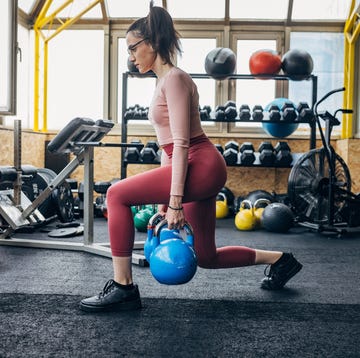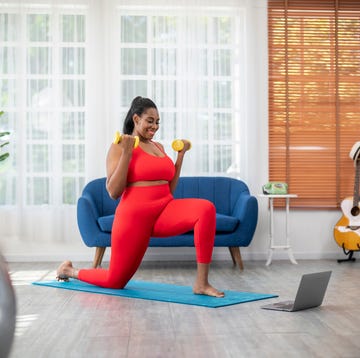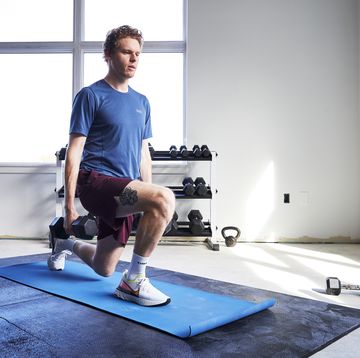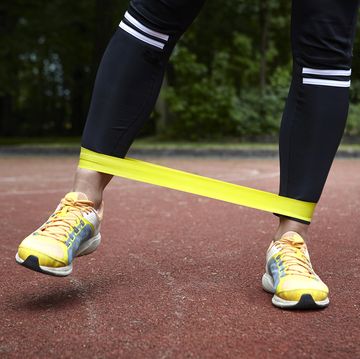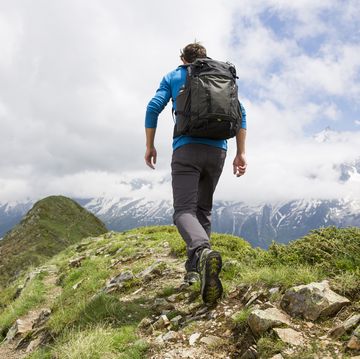Research shows that nearly half of all recreational runners get injuries, with many of those occurring in the Achilles tendon or calf. Other research pinpoints the knee, ankle, lower leg, and foot/toes as common spots runners experience aches, pains, and injuries.
Many factors can contribute to your risk of injuries, including the way you run, the shoes you wear, big jumps in mileage, and more.
The good news: There are proven strategies on what you can do to prevent running injuries before they sideline you. The caveat is that injury and injury prevention is multifaceted, so figuring out what will work for you may take time and some dedication. “A combination of things—for example, an anatomical issue plus a training error and the wrong shoes—can add up to injury,” says Joseph Hamill, Ph.D. in biomechanics and professor at the University of Massachusetts, Amherst.
Every runner is a puzzle, with a different anatomy and injury history, says Anthony Luke, M.D., M.P.H., director of the Human Performance Center at the University of California, San Francisco, “which is why injury prevention is so challenging,” he says.
Most experts agree that to unlock a lower risk of injury, you need three keys: a strong body, good form, and the right shoe—and then a combination of those keys. So here, we take a closer look at each, offering exercises, form tweaks, and shoe advice that all runners can use to lessen their chance of injury and enjoy a long, happy, ice-pack-free running experience.
1. Add Strength to Your Weekly Schedule
In the battle against injury, a runner’s best armor is a strong body. Strong muscles, ligaments, and tendons guard against impact, improve form, and lead to a consistent gait. “If muscles are weak, one footfall will not be like the rest,” says Reed Ferber, Ph.D., director of the Running Injury Clinic at the University of Calgary. “How your knee turns in, how your hip drops, how your foot pronates changes with each step. But with strength, these movements are the same each time, so your mind and body know what to expect.”
When a strong body runs, the brain tells the muscles to brace for impact before the foot hits the ground. The glutes and core contract to steady the pelvis and leg. The foot and ankle muscles are activated, providing a solid foundation to land upon.
But if one stabilizer isn’t strong enough or isn’t recruited, other muscles get overworked, and the entire chain of movement is disrupted, says Eric Orton, a running coach featured in Born to Run, creator B2R Training System, and author of The Cool Impossible.
Most runners lack strength in at least one muscle group, as well as in their neuromuscular pathways, the lines of communication between brain and body, says Jay Dicharry, M.P.T., author of Anatomy for Runners. Strong pathways help muscles fire more efficiently and in quick succession, which enables you to run with greater control and stability.
“Each step in running is like a different measure in a symphonic score, and the muscles used in running act like musicians in an orchestra, coordinating movement to make each measure shine. Any failure in this coordinated effort can affect the outcome,” explains John Vasudevan, M.D., associate professor of clinical physical medicine and rehabilitation at the University of Pennsylvania and codirector of the Penn Medicine Running and Endurance Sports Program. “The point of strengthening in running is to become fatigue resistant, so that form and coordination hold up from the first to last step of the run.”
How to use this list: These exercises, adapted from Dicharry’s and Orton’s programs, as well as input from Runner’s World coach, Jess Movold, strengthen running’s key muscles and those neuromuscular pathways. You can do them as a full routine or insert them into your day two or three times a week. If possible, do the moves barefoot.
Movold demonstrates each move below so you can master proper form. Do as many reps as listed below or the time prescribed.
Donkey Kick With Yoga Block
Why it works: By adding a yoga block or bar like a broomstick to this old-school move, you teach the body to fire the glutes without arching your back—just like you should while running. You’re also strengthening the transverse abdominis, a stabilizing muscle in your core.
How to do it: Start on all fours, knees right under hips and wrists right under shoulders, with the block or bar across lower back. Lift one leg up, knee bent at 90 degrees and keeping the block steady (if it moves, perform smaller movements), drive the heel up toward the ceiling. Then lower back to floor. Repeat. Do 10-20 reps on each leg.
Wall Press
Why it works: Activates the gluteus medius (which helps with power, as well as pelvis stabilization) in a bent-knee position, similar to running.
How to do it: Stand with right side near a wall. Bend right knee 90 degrees and make contact with the wall. Push knee into the wall and hold, while keeping body stable (don’t press shoulder against the wall). Hold for 20-30 seconds, then relax and repeat. Do 2-3 sets on each side.
Single-Leg Balance on Forefoot
Why it works: This exercise increases strength in the entire leg chain: big toes, calves, ankles, and hips. Perform it barefoot to gain the most advantage.
How to do it: Balance on one leg on forefoot (barefoot is ideal), heel off the ground. You should feel the side of hip (gluteus medius) working. Hold for as long as you can, keeping the body tall. When you lose balance, rest, then repeat 3 more times for a total of 4 sets.
Eccentric Heel Drop
Why it works: Strengthen your calves, ankle muscles, and Achilles tendons, all of which allows for a stable landing when running.
How to do it: Stand on one leg on a curb or step with heels off the edge. Lift up onto toes, then slowly lower down until heels are below the step. Repeat. Start with 1 set of 10. Build to 3 sets of 15 reps.
Clam Shells
Why it works: Strengthen your gluteus medius to improve knee and pelvis stability. To make it more intense, add a mini resistance band around the thighs, above the ankle.
How to do it: Lie on the floor on right side, hips, knees, and ankles stacked. Bend both knees, keeping legs and feet aligned. Open the knees like a clam shell, while keeping feet together and externally rotating hip. Then lower leg back down. Repeat. Do 2 sets of 30 reps on each side.
Stability Ball Bridge
Why it works: This exercise strengthens and activates the gluteus maximus and the multifidus—the small muscles in the back that aid in spine stability.
How to do it: Lie faceup with calves on a stability ball, arms extended down by sides. Lift hips up off the floor so body forms a straight line from ankles to shoulders. Hold, then lower back down and repeat. If you can hold the hips up comfortably—and without hips dropping—for 60 seconds, add another challenge: place the hands across the chest, do single leg lifts off the ball while holding hips up, or rotate hips side to side to fire up core.
Stability Ball Knee Tuck
Why it works: Strengthen your core, arm, and shoulder muscles for better running posture and stability.
How to do it: Start in a plank position, shoulders directly over wrists, with feet on a stability ball. Body should form a straight line from head to heels. (You can start with torso on the ball, then walk hands out to a plank.) Maintaining a straight spine, pull knees in toward chest. Then straighten them back out. Repeat. Start with 1 set of 10 reps. Work your way up to 3 sets of 15 reps.
Single-Leg Balance and Squat
Why it works: Develop balance in the pelvis, ankles, and feet so your body lands on a secure platform every time you take a step. Try this in front of a mirror so you can keep an eye on your form.
How to do it: Balance on one foot (shoes off, ideally), with back straight, arms in front of you, and weight evenly distributed between your forefoot and rearfoot. Once balanced, press your big toe into the floor and hold for 30 seconds. Aim for 3 sets on each leg. When you master that, do a single-leg squat by sending hips down and back, bending standing knee. Then push back up. If you can’t keep your hips even and your knee aligned over your foot, stick with just the balance move.
2. Incorporate Plyometrics
Jumping exercises increase elasticity—the springs that give running a light, bouncy feel. But they can also teach you how to minimize your impact on landing. If you’re not currently strength training, master bodyweight moves without jumps first. Then, add these plyometric exercises after performing the other moves (listed above) in this program. Start with very low reps when you’re just starting with these plyometric moves, Vasudevan says, and then gradually work up to the number of reps listed below over four to six weeks.
Squat Jump
Why it works: Squats target all your leg muscles and adding the jump turns up the burn, while also preparing your body to handle impact.
How to do it: Stand with feet slightly wider than hip-width apart. Lower into a squat by sending hips down and back. Then quickly explode up, feet coming off the ground. Land with bent knees and lower right back into a squat. Repeat. Do 10-20 reps.
Lateral Jumps
Why it works: It’s important for runners to work in different planes of motion besides front-to-back (or the sagittal plane). And this move gets you to work in the lateral (or side-to-side) plane motion.
How to do it: Place a long object (like a dumbbell or resistance band) on the ground and jump over it quickly side to side, staying on the ground as little as possible. Do 3 sets of 10 reps total. To take it up a level, switch out the pole for something taller, like a foam roller or yoga block.
Lunge Jumps
Why it works: This move helps you practice single-leg explosiveness—exactly what you need for power and speed on the run.
How to do it: Start standing with feet hip-width apart. Step right leg back and lower into a lunge, both knees bending 90 degrees. Explode up, switching legs and landing in a lunge with right leg in front. Continue alternating. Do 10-20 reps total.
Broad Jump
Why it works: Like a squat jump that powers every part of your lower body, this variation also works on forward momentum.
How to do it: Stand with feet slightly wider than hip-width apart. Lower into a squat by sending hips down and back. Then quickly explode up, feet coming off the ground and jump forward. Land with bent knees and lowering right back into a squat. Continue jumping forward or if you don’t have the space, stay low in the squat and back pedal to starting position. Repeat. Do 10-20 reps.
3. Work on Mobility
The natural stress-recovery cycle of training can cause muscle fibers to knot up and stick together, limiting their function and leaving you more susceptible to injury. Breaking down these adhesions increases what’s known as tissue mobility, which allows muscles to properly contract and lengthen. These exercises increase mobility in notorious problem areas for runners.
Focus on keeping these slow and steady (not bouncing into a stretch). Practice them after a run when your muscles are already warm. Vasudevan suggests doing them once or twice a day for four to six weeks.
Kneeling Hip-Flexor Stretch
Why it works: The leg swings like a pendulum from the hip when you run, and if you have tight hip flexors, the back swing is limited. That can contribute to overstriding (landing too far out in front of your body), which puts more stress on the leg joints.
How to do it: Kneel on one knee. Tuck pelvis under so you feel a stretch in the front of the thigh of the leg on the ground. For a deeper stretch, rotate front foot slightly out. Hold for 1-3 minutes.
Foot Massage
Why it works: Your plantar fascia, a band of tissue along the bottom of the foot, guides the foot from landing through to toe-off when you run. Limited mobility can affect this motion and lead to problems all the way up to the hip.
How to do it: Sit down and prop one ankle on top of opposite knee. Using thumbs, apply pressure to the arch of barefoot, prodding for tender areas. Press firmly on any sore, tight spots, then flex and extend the toes to release the tissue. Do for 3 minutes daily until the soreness is gone. You can also use a ball (as shown) to massage under the foot while standing, pausing on any extra sore spots and bending the toes up and down over the ball.
Calf Smash
Why it works: Knotted calf muscles are less-effective shock absorbers. This move will loosen them up.
How to do it: Sit on the floor with a foam roller under the calf of your extended leg. Roll calf over the roller, and when you find a painful spot—a sign of knotted tissue—press into the roller. Hold until the pain dissipates (usually 30-90 seconds). Alter position slightly and repeat.
Quad Roll
Why it works: Quads, or the front of the thighs, get notoriously tight from sitting all day and then working them on the run. Loosen up by rolling out.
How to do it: Lie facedown, forearms on the ground, and place a foam roller just above the left knee. Bend right knee and place it on ground to right of body. Slowly roll up and down, until you get to the top of the hip, stopping at any spot that feels extra tight for 30-90 seconds. Repeat on right leg.
Glute Roll
Why it works: Another commonly sore spot on running, work out the glute muscles with a foam roller.
How to do it: Sit on the foam roller, left knee bent and foot planted and right leg straight out, foot lifted off the floor. Slowly roll back and forth over glutes, rotating foot in and out. Pause on any extra sore spot for 30-90 seconds.
4. Focus on Form
If you want to stir up debate in your running group, bring up form. Proponents of minimalist-style running and other methods believe that just as there is a correct way to swim or swing a tennis racket, there is a right technique for running. Other experts say the way we run is individual, and messing with it invites injury.
But there is some common ground: Both camps agree that certain components of form, such as good posture and stride, can help prevent injuries.
Here’s a look at the gait cycle and where things can go wrong:
PRELANDING
Just before the foot strikes, the brain sends a signal to the muscles to prepare for impact. The muscles contract so they can stabilize the joints. If this line of communication is weak or slow, the muscles won’t get this heads-up.
IMPACT
Some studies connect the impact forces of this touchdown phase to stress fractures and other injuries. And while midfoot- and forefoot-strikes minimize forces, experts agree that the greater hazard is overstriding—when the foot lands well ahead of the knee.
MIDSTANCE
The foot is moving through pronation, and forces are at their peak, which makes this phase the most potentially injurious. Loads as high as 2.5 times your body weight pushing down on unstable hip, knee, ankle, and foot joints can wear down muscle, tissue, and bone.
TOE-OFF
The hip goes into maximal extension—if hip flexors are tight, you’re more apt to excessively arching your back.
While the debate on whether you should change your running form continues, there are a few things you can think about as you hit your stride:
1. Run with good posture
What it means: Think about keeping your upper torso straight, lower back not arched, head directly over shoulders.
Why it matters: Poor posture can put excess stress on back and knees. If your back arches, your body weight tends to shift back, making you more prone to overstriding.
Try this: Strengthen your core and upper body. Practice good posture during the day. Bad postural habits carry over to your run.
2. Swing arms efficiently
What it means: Your arm should move forward and back.
Why it matters: Arm swing affects trunk stability. An across-the-body arm swing tends to rotate the shoulders, or cause the trunk to sway, compromising core stability.
Try This: Bend your elbows about 90 degrees and let your arms swing relaxed. Keep your elbows close to your body with your hands loose, which helps the entire body relax.
3. Land lightly
What it means: Consciously land more softly. Another way to think about it: You want to “glide” or “trot” rather than “bounce” or “bound,” Vasudevan explains.
Why it matters: “When we try to run quietly, we make natural adjustments like shortening our stride and landing on our midfoot, which lessens impact forces,” says Luke.
Try this: Run in place, letting your knees rise naturally for 10 seconds. Then lean forward and run for 50 yards holding that posture. Repeat three times before you run.
4. Lead with your hips
What it means: Initiate the running motion from the center of your body.
Why it matters: Running from your hips and driving forward with your knees rather than your feet helps you maintain a tall posture and avoid overstriding.
Try this: Engage your core muscles and imagine stepping over logs while you run.
5. Evaluate your cadence
What it means: Cadence refers to your step rate—the number of footfalls you take in a minute.
Why it matters: A faster cadence can minimize overstriding and reduce forces on the joints.
Try this: Some experts see the value if your easy stride rate is 160 steps or less (a sign of overstriding) or if you’re injury-prone. Count every footfall. If you’re above 160, not injured, and not overstriding (ask a friend to shoot a video of you and check your foot and knee position), there’s little reason to change. If you want to experiment, increase it by five percent.
6. Engage your glutes
What it means: Tapping your butt just for a second or two occasionally as you run is a simple way, says Luke, to remind your body to contract and engage your glute muscles.
Why it matters: It keeps you thinking about form. “Having an awareness of what your body is doing, where your feet are, what muscles are working helps you become a better runner,” Coach Orton says.
Try this: Think about activating your glutes during your next run, at least from tree to tree or block or block.
7. Avoid overstriding
What it means: When the foot lands well ahead of the knee
Why it matters: Overstriding increases forces on the body, putting excess wear and tear on muscles, joints, and tissue.
Try this: Focus on where your foot is landing in relation to your body, and land as close to your body as possible. Your lower leg should be vertical when your foot first contacts the ground. Orton suggests this cue: When you run, rather than reaching with the foot, drive forward with the knee. Since it’s tough to overstride when climbing inclines, he recommends incorporating a weekly hill workout into your routine to give you a feel for the correct form.
Other questions about running form:
Should you try to change your foot strike?
Some experts believe that landing on your mid- or forefoot, rather than your heel, greatly reduces injury risk, and some data supports that. Others believe there’s a strong chance you’ll trade one injury for another because landing on the forefoot increases impact forces on the calf and Achilles tendon.
Further complicating the matter: Studies show that it’s difficult to know how you’re striking the ground (you think you’re midfoot- or forefoot-striking but you’re actually heel-striking, and vice versa). This is a reason some experts say it’s more productive to focus on not overstriding, which is easier to determine on your own.
The bottom line: If you’re running injury-free, most experts say don’t bother changing. But if you’re chronically injured, footstrike is another tool that could aid treatment and prevention. If you decide to try it, the transition must be gradual (Orton has runners start with just 10 minutes of forefoot landing) and accompanied by plenty of foot, ankle, and calf strengthening.
Can strength training fix faulty form?
Strength training can improve your form (makes it more stable, corrects imbalances), but it can’t resolve faulty biomechanics. If you have knock knees, for example, you will need to train your body to run differently through a process called gait retraining, says Irene Davis, Ph.D., P.T., professor in the School of Physical Therapy & Rehab Sciences at the University of South Floria.
In two studies, Davis gave runners visual and verbal cues to gradually retrain their movement patterns. The runners were able to correct their flawed form and maintain the new improved mechanics after just eight training sessions. Davis advises seeking out a physical therapist with gait-retraining experience instead of attempting it on your own. Without proper feedback, it’s difficult to know if you’re making the right corrections, she says.
5. Find the Right Shoes
We asked experts to share their take on finding the right shoes for you and why that’s so important.
Can a shoe help prevent injury?
Yes, shoes can reduce injury risk because they can alter your form and how the repetitive forces of running are applied to your body. For example, research shows that the firmness of shoe cushioning can influence the stiffness of your legs (i.e., amount of bend at the ankle, knee, and hip), which affects how forces impact your muscles, bones, and joints.
If you’re in a shoe that applies forces in a way that your body can manage and is a good match for your training (road or trail, for instance), the shoe can help reduce injury risk.
Try rotating among a few pairs: A trainer for long runs, grippy shoes for trails, flats for speed work, and minimal shoes for form drills. The variety mixes up how force is applied and may reduce stress in the legs and feet.
—Peter Larson, Ph.D., coauthor of Tread Lightly: Form, Footwear, and the Quest for Injury-Free Running
How do I know if I’m in the right shoe?
You want a shoe that fits your biomechanics. Specialty-running-store assessments are helpful but not foolproof. My best advice is to go by comfort. If it doesn’t feel good, it means it’s putting stress somewhere you don’t want it to.
If you have aches and pains after you’ve run in a pair of shoes, it might be a sign you’re in the wrong ones. If your shoe does feel good, it’s likely a good one for you.
—Benno Nigg, professor emeritus at the University of Calgary, author of Biomechanics of Sports Shoes
How can a shoe specialist help me find the right pair?
Our job is to find the shoe that best complements your foot shape and biomechanics. If we do that, we can minimize a shoe’s role in the injury equation.
Expect staff to ask about your training, look for wear patterns on your old shoes, examine and measure your bare feet, and watch you run in a few pairs. (If this doesn’t happen, I’d go elsewhere.) When a shoe feels great and allows for neutral pronation—not too much or too little movement—it's likely a winner.
—J.D. Denton, former co-owner, Fleet Feet, Davis, California, and a 30-year veteran in the running industry
Should I switch to a minimal model for injury prevention?
There is no compelling evidence that says a minimal shoe will reduce injury. Some runners have switched and have had positive, transformative experiences. Others have been hurt and disappointed.
Runners with smaller, leaner bodies, midfoot- and forefoot-strikers, and those with little or no injury history are most likely to make the switch without problems. Extreme heel-strikers and anyone with chronic injury issues will take longer to adapt and may find that their more substantial, conventional shoes work better for them.
—Martyn R. Shorten, Ph.D., managing partner at BioMechanica, LLC, Portland, Oregon
I bought minimal shoes. Now what?
Transition gradually. Spend the first week just walking in them. The following week you can start running in your new shoes—but wear them at most every other day for the first two to three weeks, and only do a mile or two in them.
Whatever amount of running you start in your new shoes, hold at that level for at least a week. Then increase only by whatever your original amount was. Gradually introduce them to harder workouts.
—Scott Douglas, Runner’s World contributing editor and author of The Complete Guide to Minimalism and Barefoot Running
Do orthotics work?
There has been surprisingly little research linking orthotics—a shoe insert that alters or controls motion—to injury prevention. But for people with excessive pronation or flat arches, inserts can help. Studies show that an over-the-counter orthotic can be just as effective as a custom-made one [unless you have a deformity from severe arthritis or trauma], so try those first. If you still have pain, see a physical therapist who specializes in running.
—Reed Ferber, Ph.D., director of the Running Injury Clinic and professor of kinesiology, University of Calgary
John Vasudevan, M.D. is an associate professor at the University of Pennsylvania. He is board-certified in Physical Medicine & Rehabilitation and Sports Medicine. He is a Team Physician for UPenn Athletics and medical director of the Broad Street Run and Philadelphia Distance Run, and previously for the Rock 'n' Roll Half-Marathon and Tri-Rock Triathlon in Philadelphia. He is a director of the running and endurance Sports Medicine Program at Penn Medicine. Dr. Vasudevan provides non-operative management of musculoskeletal conditions affecting athletes and active individuals of all levels, and combines injury rehabilitation with injury prevention. He utilizes a variety of ultrasound-guided procedures and regenerative approaches such as platelet-rich plasma and percutaneous ultrasonic tenotomy. He sees patients at the Penn Medicine and the Philadelphia Veterans Administration hospital. Dr. Vasudevan attended medical school at the University of Wisconsin School of Medicine and Public Health in Madison. After his Transitional Year in Tucson, Arizona, he went to residency in PM&R at Thomas Jefferson University in Philadelphia and onwards to Stanford University for his fellowship in Sports Medicine. He has been in practice at the University of Pennsylvania since 2012.























